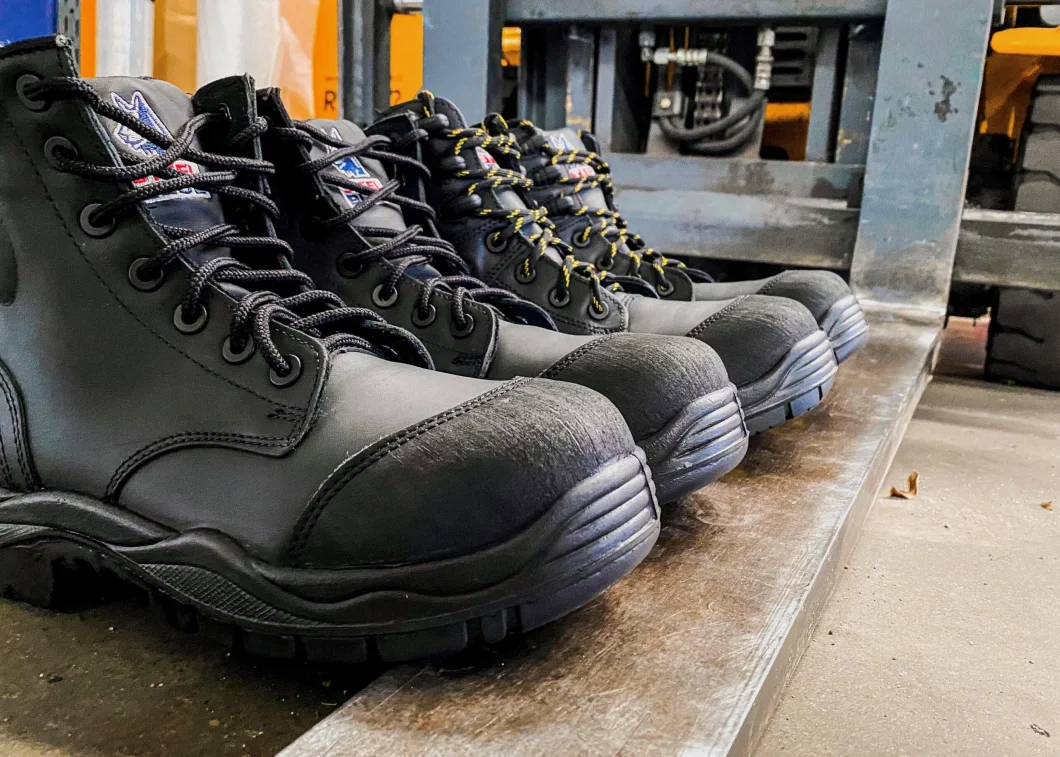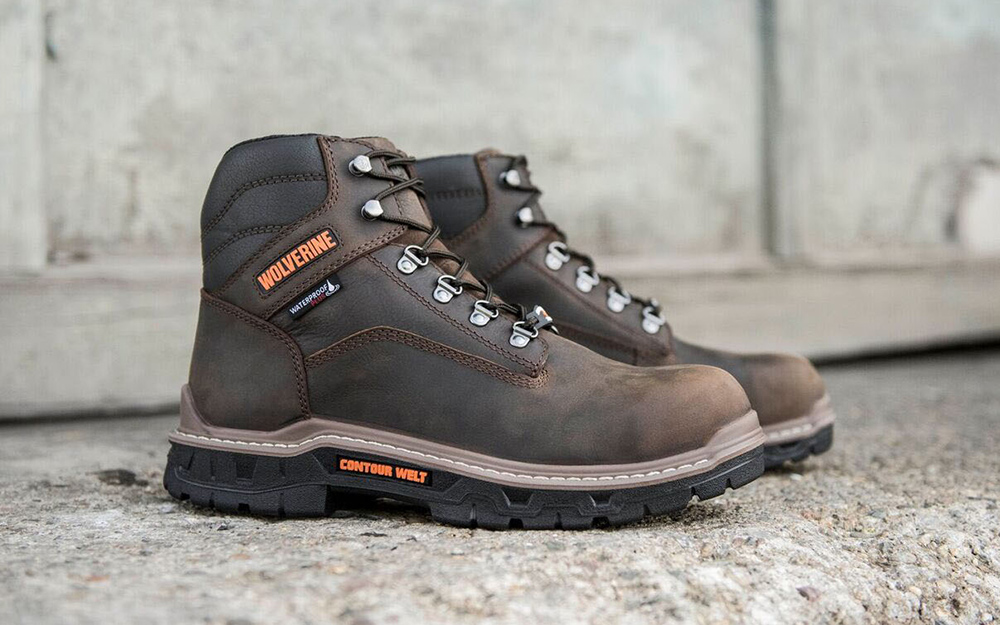Are you looking for a lightweight yet durable work boot? A composite toe work boot could be an ideal choice. With the latest technologies, composite toe boots offer superior protection and durability compared to traditional steel or alloy toe footwear.
In this guide, you’ll discover the advantages of choosing a composite toe work boot for your workplace needs.
Work boots are an essential part of any construction worker’s wardrobe and provide the wearer with the necessary protection in hazardous work environments. The ideal pair of work boots should be durable, breathable, and supportive while also providing superior protection from hazards such as sharp objects, falling objects, electrical shock, and heat or cold temperatures. Many manufacturers have developed composite toe work boots to provide more comfort, style, and protection from the aforementioned hazards without compromising the overall performance of the product.
In this guide, we’ll be discussing various advantages that composite toe work boots offer over their traditional steel toe counterparts. We’ll explain what composite toes are made of and why they provide better protection than steel toes in certain situations. We’ll also explore why these types of safety boots tend to be more comfortable for wearers who need to perform intense manual labor for long hours at a time. Finally, we’ll explain how these types of work shoes are becoming increasingly popular with both professionals and casual workers alike due to their unique combination of features that make them ideal for a variety of occupations requiring protective footwear.

Advantages of composite toe work boots
Composite toe work boots offer protection, comfort and support to ensure that workers can carry out their roles safely and effectively. The key advantages of wearing composite toe boots are as follows:
- They are substantially lighter in weight compared to steel toe-cap footwear. The reduction in weight of the boots makes them more comfortable for workers over extended periods of time, minimizing fatigue and discomfort associated with carrying a heavier burden.
- Composite toe work boots provide equal, if not superior protection when compared to steel-toe alternatives, thanks to the material’s special design and construction. Some materials used in their construction also include an additional layer of cushioning which is beneficial when walking on hard surfaces or working on uneven terrain – cushioning helps reduce shock and impact on joints, providing comfort and support during physical activities.
- Unlike steel-toe options which conduct heat (making them unsuitable for electrical contact), composite toes passes no electricity – eliminating risk of electric shock making them ideal for use around electricity or hazardous materials.
- Another advantage composite toes have over steel-toes is that they provide a greater degree of versatility – namely, unlike steel toes which are usually only available as waterproof pieces for full enclosure of the feet; composite toes come in non-waterproof designs (slip ons) often with mesh tops – offering better breathability for feet subjected to long hours outside working in hot climates or indoors where temperatures may be elevated due to equipment operation.
Lightweight and comfortable
Composite toe work boots are an excellent choice for anyone who needs foot protection, yet prefers a lightweight option. They can be made from a variety of composite materials that are much lighter than steel, such as: carbon fiber, Kevlar, and thermoplastic polyurethane (TPU).
Composite toe footwear is also designed to be form-fitting and provide superior comfort and flexibility. This makes them ideal for workers who are on their feet for long periods of time.
Additionally, since composite toes are much thinner than steel toes, they provide employees with more room in the toe box area, allowing them to move more freely while wearing them. This is especially helpful when performing tasks that require precision or complex movement.
Durability and long-lasting
Composite toe work boots are designed to be extremely durable, providing a comfortable and supportive fit that lasts for years. The composite materials used in the construction of the boot can withstand a range of temperatures and pressures from the workplace. Additionally, composite toe work boots are designed to provide strong support with minimal wear and tear on the toes.
Compared to steel-toe boots, which often have seams that can easily come undone, composite toe work boots are less likely to have any structural damage over time due to their sturdy and robust construction. Furthermore, because these work boots often feature special inner sole technology, they offer better shock absorption than other safety boot types. This increased support helps protect your feet from any injuries sustained while on the job.
By investing in composite toe work boots you can enjoy comfort, protection and durability that will last you multiple working seasons.
Choosing the right composite toe work boots

When it comes to selecting the right composite toe work boots, there are some key factors to consider. Here’s a quick guide to selecting the best pair of boots for you:
-Comfort is key. Comfort should always come first when choosing a pair of work boots. Composite toe work boots are designed to offer maximum levels of comfort and safety, so ensure that your choice fits snugly and that you can move freely in them.
-Check the cushioning. The cushioning of your composite toe work boots should be able to absorb shock and support your arches, providing the protection your feet need at all times during activities or even on those long days with limited activity. Ask your supplier for their advice on which type of cushioning is best for you and what type works best with composite toes.
-Select the right sole type. Outsole materials vary greatly across different brands, so keep this in mind when making your purchase decision. As composite toe shoes are engineered for lightness and flexibility in wear, a durable outsole material such as rubber or carbon rubber will be ideal when looking for support on a range of surfaces and terrains without compromising on durability.
-Look at the overall construction design and weight. Composite Toe Work Boots come constructed with several different features including waterproof liners and insulation material, breathable linings, aesthetically stitched uppers, rugged outsoles amongst many other features depending on what kind of protection or performance you require from them from day to day activities as well as occupation specific activities such as carpentry or electrical works etc. Ultimately comfort level depends highly on how well it fits on yours feet combined with its overall weight, usually lighter ones offer better comfort levels than heavier ones but we suggest taking product info from experts before deciding precise one for yourself.
Safety requirements of the job
Safety requirements are often the most important factor to consider when selecting a pair of work boots. For instance, if your job requires you to work near exposed electrical wiring, then it’s essential to choose a pair of boots that have reinforced composite toes. This will help protect you from electrocution and other potential hazards.
Additionally, if your job involves hazardous materials such as neurotoxins or acids then it’s important to acquire safety rated work boots that meet ASTM or EN standards for chemical exposure. Some of these safety ratings include protective properties such as waterproofing and slip/oil resistant soles.
Additionally, if you require additional support due to long hours on your feet than it’s strongly suggested to look for a pair of ankle support or padded orthopedic boots with durable rubber soles in order to reduce joint and muscle fatigue over long shifts.
Material and construction
Composite toe work boots feature a composite material that provides a lightweight yet highly durable construction. The material typically consists of Kevlar or Carbon fiber and is designed to fit the shape of the foot for an enhanced fit and stability during movements.
This type of boot also features advanced heat insulation and protection against electrical hazards, typically provided by a comfortable layer of breathable foam insoles. The outsole is usually made of rubber and offers slip-resistance to prevent slips, trips, and falls in the workplace.
The uppers are usually constructed using Nylon Mesh fabric giving them flexibility when moving around at work while providing extra protection against spills or liquids in the workplace.
Comfort and fit
Composite-toe work boots provide maximum comfort for the wearer. The composite material used in the toe box is lightweight and flexible, making it easy to break in and move freely with. Additionally, this type of toe box eliminates the possibility of heavy metal residue being left behind after exposure to cold or moisture.
Composite toe work boots can also be designed to match a particular foot shape more closely than steel toe boots, providing an even better fit. This helps to improve cushioning at the feet and can prevent feet fatigue. Furthermore, many composite toe boots come with additional padding at the front of the shoe as well as at other key pressure points within the shoes. This helps protect against blisters while providing top quality comfort all day long.

Maintenance and care of composite toe work boots
Maintaining and caring for a pair of composite toe work boots is essential in keeping them functional and reliable. It’s important to follow the instructions outlined by the manufacturer when cleaning, caring, and storing your boots. This can extend the life of your shoes and ensure they remain reliable while you’re on the job.
When caring for composite toe work boots:
-Clean them after every use with either a dry cloth or a soft bristled brush. Gently remove dirt and debris from your shoes with a damp cloth. Avoid scrubbing or getting the leather too wet; this may cause damage to your shoes.
-Spray them with a waterproofing agent designed for work boots to widen their resistance against water threats. Reapply after each exposure to liquid or damp conditions, following the manufacturer’s direction carefully.
-Regularly apply an all-weather conditioner that adds suppleness to their surfaces and prevents cracking in dry weather. Applying oil will help prevent damage from flexing as you move while adding moisture back into the material they are crafted of, prolonging their life overall.
-Store your boots in a cool, dry place that is away from direct sunlight; hot temperatures or humidity can wreak havoc on leather materials over time and cause premature breakdowns in composite shoe components as well.
Cleaning and conditioning
Cleaning and conditioning your composite toe work boots is essential to maintaining their performance and longevity. To clean them, remove loose dirt and other debris from the surface before applying a cleaner designed for leather. Be sure to follow the cleaner’s specific instructions for best results.
Once the leather is clean, use a sponge or damp cloth to apply leather conditioner or saddle soap to your composite toe work boots. This will help keep them soft, supple and waterproof, as well as reduce creases and cracking caused by wear.
When you’re done conditioning your boots, let them dry naturally in a cool space away from direct sunlight.
Inspection and replacement of worn-out parts
Regular inspections of composite toe work boots should be done to ensure proper fit, maximum safety, and protection. Wearable parts and components including the toe box, sole unit, midsole, outsole treads, hardware and laces should never be ignored.
Lead times on ordering new replacement parts can vary with different manufacturers so check online or call the manufacturer for availability. The tread of outsole must thoroughly be checked for signs of wear or damage that affects its gripping capacity; even if the rubber layer appears intact but is worn-down through continual use (due to abrasion), it’s time to order a new pair.
If such wear and tear can’t be seen by looking at it carefully, it is advised that boots with composite toe boxes be replaced since they are unable to last forever even with the highest quality craftsmanship.
If any part of a composite toe boot has perceptible defects such as holes or cracks, replacements must need to be ordered right away to ensure protection and safety.
Storage and protection
Composite toe work boots are designed to provide the highest level of protection while allowing you to move with greater ease and flexibility. That’s why they’re perfect for industrial settings, especially those with hazardous conditions. To ensure your composite toe work boots stay in pristine condition and last as long as possible, proper storage and protection is essential. There are a few key steps you should take to properly store and protect your composite toe work boots.
First, make sure that your composite toe work boots are fully dry before storing them away. Allowing wet or damp boots to sit or remain in enclosed spaces can cause mold or mildew buildup that may be difficult or impossible to remove. Drying your boots before storing them is an easy step that will ensure your boot remains durable for years to come.
Second, invest in a good quality leather conditioner specifically designed for use on leather-made footwear such as composite toe work boots. This will lock in moisture to keep the leather soft and pliable so it won’t crack, crease, fade or otherwise look worn out prematurely. Regular conditioning treatments will also help prevent issues with fungus from spoiling exposed leather surfaces over time so the outer shell looks new even after years of wear and tear.
Third, store your composite toe work boots in a dry place away from direct sunlight exposure whenever possible. Heat and UV light can break down the protective layers of wax in leather footwear over time if subjected continuously; therefore storing the pair away in dark places where direct sunlight isn’t present will reduce the rate at which this happens significantly for better longevity of materials used on the shoes themselves inside-out.
Conclusion
In conclusion, it’s clear that composite toe work boots have many advantages over traditional steel toe boots. As they are much lighter than steel toe boots, they allow for greater comfort and mobility. They also offer superior protection against electrical hazards, as well as increased flexibility in extreme temperatures.
They are also much more affordable than steel toe boots, so if you are in the market for a more comfortable and economical pair of protective footwear for your job, then composite toe work boots may be the perfect option for you.

FAQ’s
What are composite toe boots good for?
Composite toe boots are good for providing protection to the toes while being lighter and more comfortable than traditional steel toe boots. They are commonly used in industries where foot protection is required, such as construction, manufacturing, and transportation.
Are composite toe boots comfortable?
Yes, composite toe boots are generally more comfortable than steel toe boots as they are lighter in weight and do not conduct temperature like metal does. They are also more flexible, allowing for greater range of motion.
How safe are composite toe boots?
Composite toe boots are designed to meet safety standards and provide protection to the toes in potentially hazardous work environments. They are safe as long as they are used according to the manufacturer’s specifications and guidelines.
What are the pros and cons of composite toe boots?
The pros of composite toe boots are that they are lightweight, more comfortable, and do not conduct temperature like metal. The cons are that they may not provide as much protection as steel toe boots in some situations and can be more expensive.
Is composite better than steel toe boots?
It depends on the specific needs of the user. Composite toe boots are generally lighter and more comfortable, but steel toe boots may provide more protection in certain situations.
What are the benefits of toe shoes?
Toe shoes, also known as minimalist shoes, have several benefits such as providing a more natural feel and better control of foot movements, improving balance and stability, strengthening foot muscles, and reducing the risk of injuries.
Will composite toe boots break in?
Yes, composite toe boots can break in and become more comfortable over time, just like any other type of footwear. It may take some time for the boots to mold to the shape of your feet, but with regular use, they should become more comfortable.
Do composite toe boots get cold?
Composite toe boots do not get as cold as steel toe boots because they are made of non-metallic materials that do not conduct heat or cold as easily. However, if you work in very cold temperatures, you may still need to wear insulated boots to keep your feet warm.
Is composite toe better than aluminum toe?
Both composite toe and aluminum toe boots have their advantages and disadvantages. Composite toe boots are generally lighter and more comfortable, while aluminum toe boots are more durable and offer better protection against heavy objects. The choice between the two depends on your specific needs and preferences.
How much can composite toe withstand?
The strength and durability of composite toe boots can vary depending on the specific materials used. However, most composite toe boots are designed to meet or exceed safety standards and can withstand impacts of up to 75 pounds or more. It is always important to check the safety ratings and specifications of your boots before using them for work or other activities.
See Also:
- Best slip on work boots 2023
- Best steel toe boots for warehouse work 2023
- Best boots for irrigation work 2023
- Best steel toe waterproof work boots 2023
- Best steel toe waterproof work boots 2023

